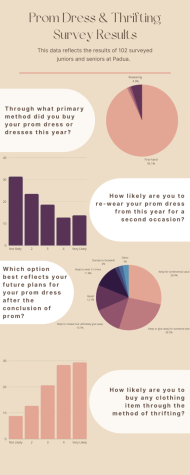Upperclassmen Thrifting Everything But a Prom Dress
Juniors Shannon Grier and Joe McGrellis pose for a photo in front of a shark at the Adventure Aquarium in Camden, N.J. Concerning her choice to rewear her prom dress, she said, “It’s too expensive and pretty for me just to wear it once.”
Opening up Instagram, users will find over 8.8 million posts under the hashtag “thrifting.” But scrolling through the top posts, not many will find images of prom dresses. This trend of buying first-hand instead of second-hand dresses extends beyond the virtual community to the local community as well.
Junior Amneris Romero-Martinez was one of only 6.9 percent of surveyed seniors and juniors who wore a second-hand dress for their prom this year.
“I ended up getting a dress from my mom, which is second-hand, because I thought it would be more convenient than going through the hassle of going prom dress shopping,” she said.
Romero-Martinez added that “at least 40 percent” of her closet consists of thrifted or second-hand clothing, a majority of it coming from her mom. But this second-hand dress experience was not shared by all who lead a thrifting lifestyle. Senior Jessie Vavala, who estimated an even larger percentage of 60 percent of her wardrobe to be thrifted, struggled to find a second-hand dress.
“Finding formal wear in my size at second-hand shops and thrift stores is usually a challenge for me,” she said. “I did look for options at Goodwill and other thrift stores, but nothing that would really have worked without a lot of tailoring.”
Another frequent thrifter, junior Anna Rose Ahearn, said she views prom or other special occasions as acceptable exceptions to a lifestyle of thrifting. She ultimately bought both her prom dresses first-hand this year.
“Prom dresses have a different style to me that aren’t really in thrift stores,” she said, “but I did consider it. I also considered using my mom’s old dresses but it just didn’t work out.”
The 93.1 percent majority of upperclassmen who bought prom dresses first-hand still have the opportunity to give their dress more use by wearing it a second time. Romero-Martinez hopes to wear her prom dress again in the future.

“I think there’s a mentality where clothes are really disposable,” she said. “[But] you can rewear your clothes. It doesn’t have to be a one-and-done situation.”
About 13.7 percent of students surveyed said that they are very likely to rewear their prom dress for a second occasion. Vavala said that she “paid more money than clothes ever need to be for it” so she will make the effort to wear her dress again.
“I’m wearing the same dress to Sallies prom, and I think I’ll keep it in my closet in the event of another formal affair,” she said. “It’s a great color, good fit, and well constructed.”
A larger majority of 70.7 percent of those surveyed said they plan on keeping their dress for someone else to wear, rewearing, donating, upcycling, or reselling their prom dress. Junior Shannon Grier added that she decided to donate her prom dress to underprivileged girls in addition to rewearing it for another prom.
“I do not have specific program in mind but I chose this method of donation because prom dresses are very expensive these days, especially for a good quality one,” she said. “I want to give [it to] girls who do not have a lot of money or access to a dress that they can wear for prom.”
A 2018 review in the “Journal of Cleaner Production” found that reusing prom dresses and other clothing items can extend the lifetime of pieces and reduce its environmental impact. But despite the rise in second-hand shopping, around $500 billion worth of clothing are wasted every year. Romero-Martinez described the waste specifically from fast fashion as “absolutely insane.”
“There’s this mentality where, ‘Oh, it’s cheap and easily accessible, I‘ll just wear it a couple times and throw it out, it’s fine,’ but it just adds to a culture of overconsumption and huge waste, which isn’t good for anyone,” she said. “I think thrifting is fun and cool and it’s inexpensive.”
But she did not always love thrifting from the beginning. Romero-Martinez witnessed thrifting begin to come into style more recently.

“When I was younger, there was a lot of stigma around it and I was like, ‘Oh, I don’t thrift,’” she said. ”But, as I got older, it started to become cool and I was like, ‘Oh, this is a thing that’s cool and it’s also helpful for the environment and it’s fun.’”
Beyond prom, 29.4 percent of surveyed students said they were very likely to thrift any item of clothing. Romero-Martinez said she “100%” encourages her friends to thrift or share clothes.
“Thrift everything that you can,” she said, “It’s fun going out and trying all these pieces and yes, it’s a little stinky in there, a little dusty, but it’s fun. You can make it fun.”
Juniors Shannon Grier and Joe McGrellis pose for a photo in front of a shark at the Adventure Aquarium in Camden, N.J. Concerning her choice to rewear her prom dress, she said, “It’s too expensive and pretty for me just to wear it once.”
Anna Rose Ahearn ‘23 smiles for a picture in her prom dress. She said she will “offer my prom dresses to my underclassmen friends” after the event.

Maggie is a senior at Padua Academy. She took Journalism to continue to take advantage of Padua’s media classes, she has been involved in PATV and the...









